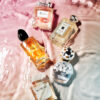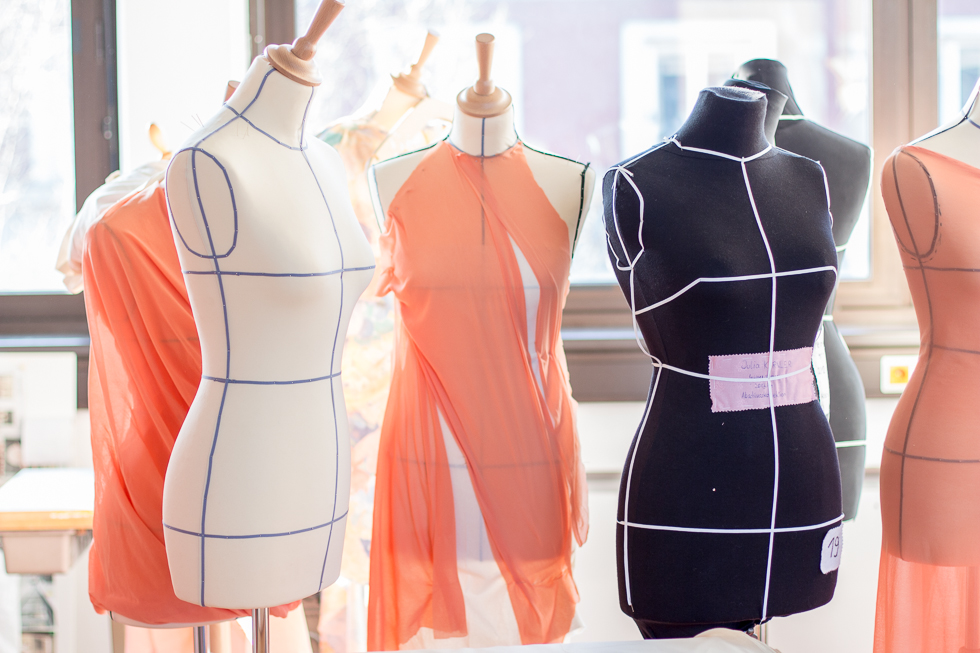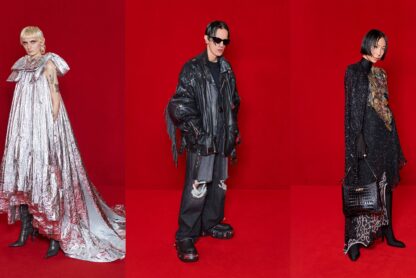When you learn about fashion, it’s interesting to discover the history of legendary fashion houses and their designers and iconic pieces. But it’s also important to know the main textiles used in the fashion industry.
Whether you want to work with fabrics directly such as becoming a fashion designer, product developer, or pattern maker; or even if you want to become a fashion journalist and cover fashion shows, you need to recognize textiles when you report a runway. Overall, no matter the department you want to get into, you need to know the products and it starts with knowing textiles.
From cotton, polyester, and nylon to silk, linen, denim…how much do you know about the different types of textiles? In this article, we are going to explain what are textiles and provide you with a complete guide to fashion fabrics.
What Are Textiles: A Guide to Fashion Fabrics
Fashion textiles refer to the materials and fabrics used in the creation of clothing, shoes, bags, and accessories. They play a crucial role in fashion because without them, these items simply couldn’t be produced. In addition, it’s important to know what we wear. It’s not just a beautiful Dior dress, an elegant Chanel suit, or a timeless Prada bag that we wear. It’s particular textile fibers that have been transformed into a finished product.
Textiles allow us to determine the look, feel, and quality of fashion items. Fashion designers and manufacturers select textiles based on various factors. It includes the desired style, comfort, durability, and functionality of the final product. It’s important to understand different fabrics and their unique qualities. This is to ensure that the appropriate fabric is chosen for specific products.
There are many different types of textiles; some are made with natural fibers, while others are synthetic. What’s more, the production of some textiles can be achieved by blending natural and synthetic fibers to combine the best qualities of each.
Textiles in Fashion
Chiffon

Chiffon is a soft, lightweight, and sheer fabric with a slightly rough texture. It is often used to create delicate and elegant garments such as blouses, eveningwear, bridal gowns, lingerie, and scarves. It is typically made from silk, but it can also be produced from synthetic fibers like polyester. Due to its transparency and good draping quality, chiffon is a good fabric for overlays and sleeves.
Corduroy

Corduroy is characterized by a distinctive pattern of twisted fibers that lie in raised parallel lines, or “cords.” It’s created by weaving extra sets of fiber into the fabric. These are then cut to create the characteristic ridges (they can be narrow or wide depending on the type of corduroy).
This fabric is typically made from cotton. However, it can also be found in blends with other fibers, such as polyester or spandex. It is a relatively thick and warm fabric. It makes a popular choice for fall and winter clothing. Its strong, resistant structure makes it suitable for clothing items that need to withstand everyday use. This include but not limited to, pants and jackets, as well as upholstery. Corduroy comes in a variety of colors, although earthy tones like brown, tan, and olive are the most common.
Cotton

Cotton is one of the most widely used and important natural fibers used in fashion. The fibers are composed of nearly pure cellulose, which gives them their characteristic softness and breathability. It is known for its durable and absorbent properties. Cotton is a versatile fabric and is used for a wide range of clothing items, home supplies, and some non-textile products.
There are several varieties of cotton:
- Pima (the finest cotton and more expensive than the standard cotton)
- Supima (the name is trademarked by the Supima Association, which requires its cotton be exclusively grown in the USA)
- Organic cotton. Although cotton is a renewable and biodegradable resource, the environmental impact of cotton cultivation, particularly water usage and pesticide use, has led to increased interest in sustainable and organic cotton which is more eco-friendly as it uses non-genetically modified plants, and without the use of any synthetic agricultural chemicals such as fertilizers or pesticide.
Denim

Denim is a sturdy cotton twill fabric. It can be mixed with elastane to give stretch to what is otherwise a rigid fabric. So, denim is commonly associated with jeans, created in 1873 by Levi Strauss. It has a characteristic blue color, with the warp threads being dyed using indigo. Throughout the years, denim has expanded to other items (jackets, skirts, dresses, shirts, and shorts), and other colors.
Also, denim was first adopted in the early 20th century as the preferred material for workwear. This include western miners, cowboys, farmers, and other blue-collar workers in the United States. In the 1950s, it exploded in American culture. It became a cultural icon with the rise of new jeans styles and designer denim in the 1970s.
Elastane

Elastane is known as spandex in the United States and Canada and as lycra in other parts of the world. It is a synthetic fiber that is highly valued for its exceptional elasticity. Elastane is valued for its exceptional elasticity. It can stretch up to 600-700% of its original length and then return to its original shape without losing its elasticity! Also, elastane is often blended with other fibers, such as cotton or polyester. It’s blended to add stretch and flexibility to textiles, making it a valuable component in sportswear, activewear, swimwear, and undergarments.
Fur and Faux Fur

Fur clothes are made from animal pelts and are mainly used in the creation of fur coats and accessories.
Faux fur, aka fake/synthetic fur, is an animal-friendly and less costly alternative to fur, meant to give the appearance, texture, and warmth of animal fur without using real fur. Instead, it is made from synthetic fibers. it is typically polyester, acrylic, or a blend of various materials. Then, it’s processed, dyed, and cut to match a specific fur texture and color. Many designers banned real fur from their collections and adopted faux fur for ethical and sustainable purposes.
Flannel

Flannel is a soft woven fabric made from wool, cotton, a blend of both, or synthetic fiber. It is characterized by its raised, brushed surface, which gives it a soft and slightly fuzzy texture. Flannel is commonly used for fall and winter garments, and is a popular material for shirts, sleepwear, and loungewear. These flannel garments often feature plaid or tartan designs. Although they can also be found in solid colors or other patterns.
Flannel has an important historical significance. It has been one of the main key pieces in grunge fashion in the 1990s.
Jersey

Jersey is a knitted fabric characterized by a smooth surface and good stretch and drape. It is mostly used in the production of everyday clothing that requires comfort and ease of movement, especially for activewear and sportswear, and other casual items. Jersey fabric can be made from various materials, but it is typically made from cotton or a blend of cotton with synthetic fibers like polyester or elastane (spandex).
Leather

Leather is created by tanning animal hides or skins, including sheep, goats, pigs, and exotic animals like alligators, crocodiles, and snakes. Mostly used on accessories, like handbags, belts, and wallets, but also for clothing and shoes, leather skins give garments a luxurious appearance; it is also known for great durability and longevity.
There are different types of leather; some are smooth, while others have a more pronounced grain or texture, such as full-grain leather (which retains the outermost layer of the hide, known for its natural markings and strength), top-grain leather (with the top layer sanded and finished for a more uniform appearance), and various types of split leather.
Due to a growing interest in sustainable leather production to reduce the environmental impact, fashion designers started using alternatives to traditional leather, such as lab-grown or plant-based leather.
Linen

Linen is a natural textile material made from the fibers of the flax plant, which is known for its slender stems and blue flowers (Linum usitatissimum). It is one of the oldest and most widely used textiles in the world, valued for its cooling effect and high breathability, making it the perfect material for spring and summer. Linen has a distinctive, slightly rough texture and wrinkles with a characteristic slubbed appearance (slubs are small, irregular knots or imperfections in the fabric, that add to its natural and rustic charm. Linen is typically off-white or pale beige in its natural state, although color variations do exist.
Nylon

Nylon is a generic designation for a family of synthetic polymers, known for its strength, durability, lightweight, and quick drying. In fashion, this fabric is used in a wide range of products, including clothing (stockings, swimwear, jackets), as well as luggage and backpacks.
First developed by American company DuPont in the 1930s, Nylon was the first synthetic fiber produced. It had a major breakthrough in 1984 when Miuccia Prada introduced the first nylon backpack. Nowadays, Nylon is a popular material used to make bomber jackets, bags, and other items.
Polyester

Polyester is one of the most widely used textiles in the world. It is a generalized term for any synthetic fabric or textile which is made using polymers or plastic materials that is created through a chemical process. This fabric is known for its low cost and not being sustainable as it is created from fossil fuels with the main ingredient being ethylene, a derivative of petroleum. Fortunately, polyester can be recycled and used in the production of new polyester products.
The main characteristics of polyester are durability, wrinkle resistance, color retention, lightweightness, and quick drying. It is thus used in a wide range of products, including clothing, bedding and linens, upholstery, curtains, and various technical and industrial applications, including automotive parts and packaging materials.
Satin

Satin is a shiny fabric, easily recognizable for its smooth, glossy, and lustrous surface, which is achieved by using a weaving technique called “floats,” in which the threads are woven in a way that the majority of them run along the surface of the fabric.
Originally satin was made of silk and was very expensive, so it was used only by the upper classes and royalty. Nowadays, cheaper synthetic versions made it available to a wider range of customers.
Satin is commonly used in lingerie, nightwear, evening attires, and bridal gowns, as well as for linings and accessories like ribbons and bows.
Sherpa

Sherpa is a soft and cozy fabric typically made from cotton, polyester, or acrylic, designed to mimic the fluffy texture of sheep’s wool and look of traditional Sherpa wool, which is commonly used in the Himalayan region to make warm and durable clothing. It is designed to provide warmth and can be used as a lining or material in cold-weather clothing – on jackets, coats, hoodies, vests, hats, mittens, and home textiles.
Silk

Silk is one of the most luxurious fabrics in the world, a natural fiber known for its fine texture, softness, and natural sheen. It can be blended with other fibers, such as cotton or wool, to create fabrics with unique properties.
China has long since maintained a position as the world’s number one manufacturer of Silk, and was key in the formation of the Silk Road. Silk has been highly valued for centuries and is quite expensive. Its elegant appearance makes it a perfect choice for high-end clothing including evening gowns and tuxedos, blouses, pajamas, lingerie, and ties.
Suede

Suede is a type of leather with a soft, velvety texture that is achieved by sanding or buffing the inner side of the animal hide, typically from cattle, goats, pigs, and lambs. The material suede leather is known for its luxurious feel and is more flexible than full-grain leather, though it is not as rugged or resistant to water. Suede is often used in the production of high-quality shoes, clothing, and accessories.
Tulle

Tulle is a lightweight, fine, and sheer fabric that is delicate in appearance. It has a fine mesh or net-like structure, and a soft and fluid drape. This allows it to be used in a wide range of products: wedding veils, bridal gowns, ballet tutus, costumes, and so on. Tulle is also praised for its ability to add volume and structure to garments, especially in dresses, petticoats, and skirts. This fabric is often made from various materials, but synthetic fibers like nylon and polyester are commonly used.
Tweed

Tweed is a natural textile made from wool, although it can also incorporate other natural fibers like silk, cotton, and linen, allowing to create warm garments. Its texture is rough but this makes it durable. Tweed comes in various traditional patterns, including herringbone, houndstooth, and plain weaves, which often come in earthy and rustic colors.
Also, tweed traces its origins in Scotland and Ireland. It is traditionally associated with country and outdoor wear, making it a favored choice for hunting, fishing, and other rural activities, but not only. Tweed has made its way into everydaywear and formalwear, as well as high-end fashion. From jackets, suits, skirts, pants, hats, and coats, to accessories like scarves, caps, and handbags, tweed is a popular choice for many items.
Velvet

Velvet is a luxurious fabric known for its plush texture and a natural sheen. It can be made from a range of materials. It can include silk, cotton, viscose, and synthetic fibers like polyester, and silk velvet is considered the most luxurious. Warm and durable, velvet is often used for high-end and elegant clothing. It could be used for formal attires, bridal wear, dresses and skirts, suits. Sometimes, it’s used for accessories, and home furnishings.
Viscose

Viscose, also known as rayon, is a man-made fiber. It is produced from natural sources, through cellulose, often extracted from trees (wood pulp, bamboo…). It cannot be defined purely as “natural” or “synthetic.” Viscose derives from a natural source. It undergoes a chemical process to transform the cellulose into a fiber, making it a semi-synthetic material.
Viscose has a soft and smooth texture, which can be mistaken for cotton or silk. It is often blended with other fibers, such as cotton or polyester. It’s blended to enhance specific properties like strength, durability, or wrinkle resistance. These qualities make it a versatile fabric used for all kinds of garments.
Some types of viscose, such as Tencel or Lyocell, are produced using more environmentally friendly processes and are considered more sustainable.
Wool

The wool material is a natural fiber derived from the hair of animals. It’s commonly fleece of sheep, goats (cashmere and mohair), rabbits (angora), and even certain camel species (camel hair). These are all different types of wools.
Wool is well-known for its natural insulating properties. It makes a highly effective material for keeping the body both in warm in cold weather. It is also one of the most eco-friendly materials.
I hope this article provided you with insight into the most common textiles. Feel free to keep it as your go-to dictionary of fashion textiles whenever you want to recall something about them.
If you enjoy learning fashion terms, check out our article about the 30 most common terms used in the industry here.
You can also learn about the history of fashion in our online course Inside the fashion industry, and if you want to land a job in fashion fast, enroll in our free masterclass.










“Grateful for your support; committed to crafting content that captivates and links effortlessly.”
archie andrews jacket